PneumoMachinic
June 9 - August 18 2024
The gathering of our existence can be fulfilled through breathing. It is a vehicle both of proximity and of distancing, of fidelity and of destiny, of life and of cultivation […] Life is cultivated by life itself, in breathing. LUCE IRIGARAY
What is breath? Across cultures, breath has been considered a manifestation of life, influencing symbolic, conceptual and abstract thought. Cultural arguments and questions around the primacy of breath vs being haunt the writings of philosophers such as Irigaray, Heidegger, Derrida and Descartes.
Anatomically, breath informs the voice: the original musical instrument. One theory suggests that human language began with mimesis; paramusical imitations of sounds in our natural environment; birds, animal calls. Controlling breath through the human instrument certainly resulted in profound changes to our bodies and brains; advancing the evolution of speech and culture. It has even been suggested that the ability to gain breath control was the key to unlocking language and defining our evolution as a species. About 70,000 years ago the technology of wind instruments allowed us to multiply, extend and enhance the effects of human breath..
PneumoMachinic (breath machines) is a sound-art exhibition which considers the influence and cultural impact of breath...from the earliest human speech, to installations evoking the ancient music of Peru and Spain. Three artists have created air-driven, sound installations through exceptional research and complex technologies. Their works explore, expand and compress breath; evoking, mechanizing and instrumentalizing it in meaningful flows, beats, currents and code.
Ali Miharbi has had a long interest in the materiality of sound and the roots of communication. His research into tangible technologies and physical forms of communication, included speech and language itself as a technology. Whispering I reconstructs the human vocal tract, allowing us to hear the earliest speech sounds capable of carrying distinct meaning. The work suggests the origins of language, the development of the human voice instrument, and the meaning of a whisper. This fragile orchestra of vocal tracts, articulate sounds that are both familiar and unintelligible, suggesting a struggle… somewhere between a private whispered communication and the physical need to breathe.
The process of creating El Etorno Retorno, Cristhian Ávila Cipriani required permission to examine and reproduce ancient, pre-hispanic, ceramic musical instruments connected with his own ancestral origins. A selection of exquisite flutes were scanned inside and out using advanced tomographic technology, then carefully 3D printed with ceramic material. A large windmill, built and installed at MALI (Museo de Arte de Lima) for this exhibition, captures and measures wind data flowing over the museum, sending it live to New Media Gallery computers. The wind data powers a pneumatic pump in the gallery, breathing air into the simulated instruments, playing them again after centuries…a haunting, aleatoric orchestra. The artist questions the components of this breath and the performance, and whether sound changes as the body changes.
Xoán-Xil has created Organismo, a series of small wind-instrument automata, each equipped with bellows, pulleys and acoustic mechanisms ; operated through choreographed breaths of air and a series of calibrated movements. Scattered across the floor, this displaced orchestra conjures up what the artist refers to as a mechanical ornithology - some exquisite bird species in a strange, techno-landscape. Organismo was inspired by historic organs from the Baroque, which emerged from the post-new-world-contact period in Spain. The 17th-18th century organ technology reflects the sudden interest in paramusical sounds reflecting a vibrant natural world of birds, wind, rain, hurricanes.
Curation + Design: Sarah Joyce + Gordon Duggan
Cristhian Ávila Cipriani (Peru)
El etorno retorno (2021)
HD 12 3D printed Prehispanic instruments, micro controllers' windmill, weather station, compressor
Replicas of pre-hispanic musical instruments, from separate archaeological explorations, located in international collections. Recreated using 3D scanning and modelling. Tomographic examination created an internal and external map of each instrument. 3D Printed in clay-like material. Connected to a pneumatic system following random data collected from the wind. A tower with sensors is installed in Peru, capturing the wind data, high enough to avoid any obstacles that could alter the quality. Data is sent to an Arduino plate that interpolates the information. The plate is connected to the pneumatic system that introduces pressurized air into the system. Solenoid valves open and close, allowing air to blow the replica instruments, producing sound.
The Eternal Return is an art installation that seeks to impact on the private and collective imaginary using 3D impressions from pre-hispanic musical instruments, that are again ‘played’ by the wind with technological assistance. The intention is to hear random interpretations of someone else’s past. This process makes us wonder about how we understand time and, as in the paradox of Theseus’ ship, can we confirm that the sound is the same if the body changes?
In the first instance, The Eternal Return, pre-Hispanic Interactions project revisits a real everyday aspect of pre-Hispanic Peru: sound. For this purpose, replicas of musical instruments discovered in different archaeological explorations are used and integrated into a musical, interactive, and incidental installation. In the second instance, the project seeks to re-access and re-imagine the pre-Hispanic pieces found in different collections around the world, in order to fill in some of the gaps in our history knowledge of this period. The installation aims to unveil a collective consciousness through the sound experience.
The process begins with the collaboration of institutions in the loan of pre-Hispanic pieces from their collections. These go through a tomographic examination to make an internal and external map of them. These are then printed in a 3D material that has clay-like qualities. Then these pieces are connected to a pneumatic system that injects pressurized air into each of them randomly, following data collected from the wind. At the same time, we used a tower with the sensors to capture the wind data, high enough to avoid any obstacles that could alter the quality. This data is then sent to an Arduino plate that interpetrates the information, the plate is also connected to an pneumatic system that will introduce pressurized air into the system. In the end, some solenoid valves open and close giving way to the air that “blows” the replicas producing sound.-Hispanic Interactions project revisits a real everyday aspect of pre-Hispanic Peru: sound. For this purpose, replicas of musical instruments discovered in different archaeological explorations are used and integrated into a musical, interactive, and incidental installation. In the second instance, the project seeks to re-access and re-imagine the pre-Hispanic pieces found in different collections around the world, in order to fill in some of the gaps in our history knowledge of this period. The installation aims to unveil a collective consciousness through the sound experience.
The process begins with the collaboration of institutions in the loan of pre-Hispanic pieces from their collections. These go through a tomographic examination to make an internal and external map of them. These are then printed in a 3D material that has clay-like qualities. Then these pieces are connected to a pneumatic system that injects pressurized air into each of them randomly, following data collected from the wind. At the same time, we used a tower with the sensors to capture the wind data, high enough to avoid any obstacles that could alter the quality. This data is then sent to an Arduino plate that interpetrates the information, the plate is also connected to an pneumatic system that will introduce pressurized air into the system. In the end, some solenoid valves open and close giving way to the air that “blows” the replicas producing sound.
Image
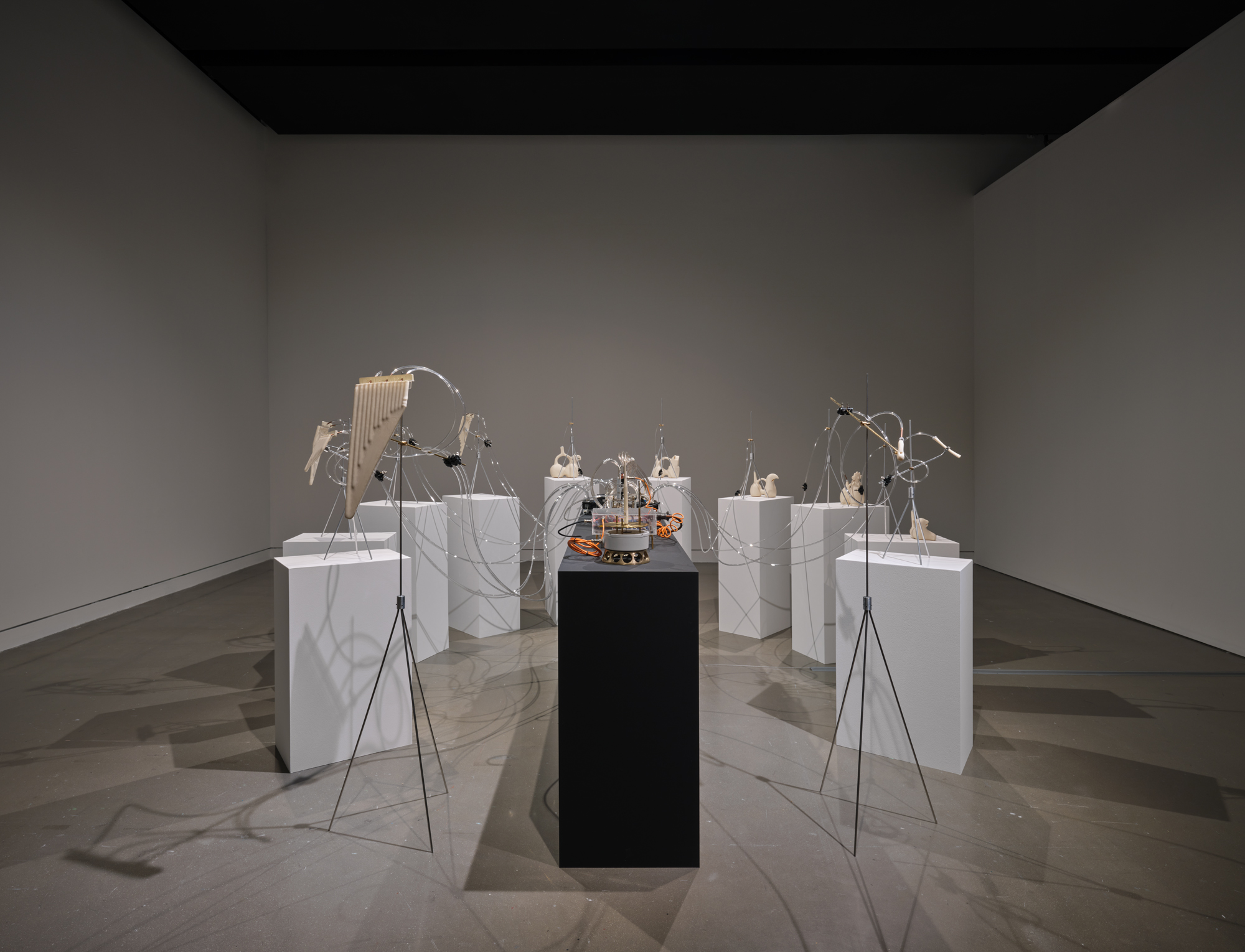
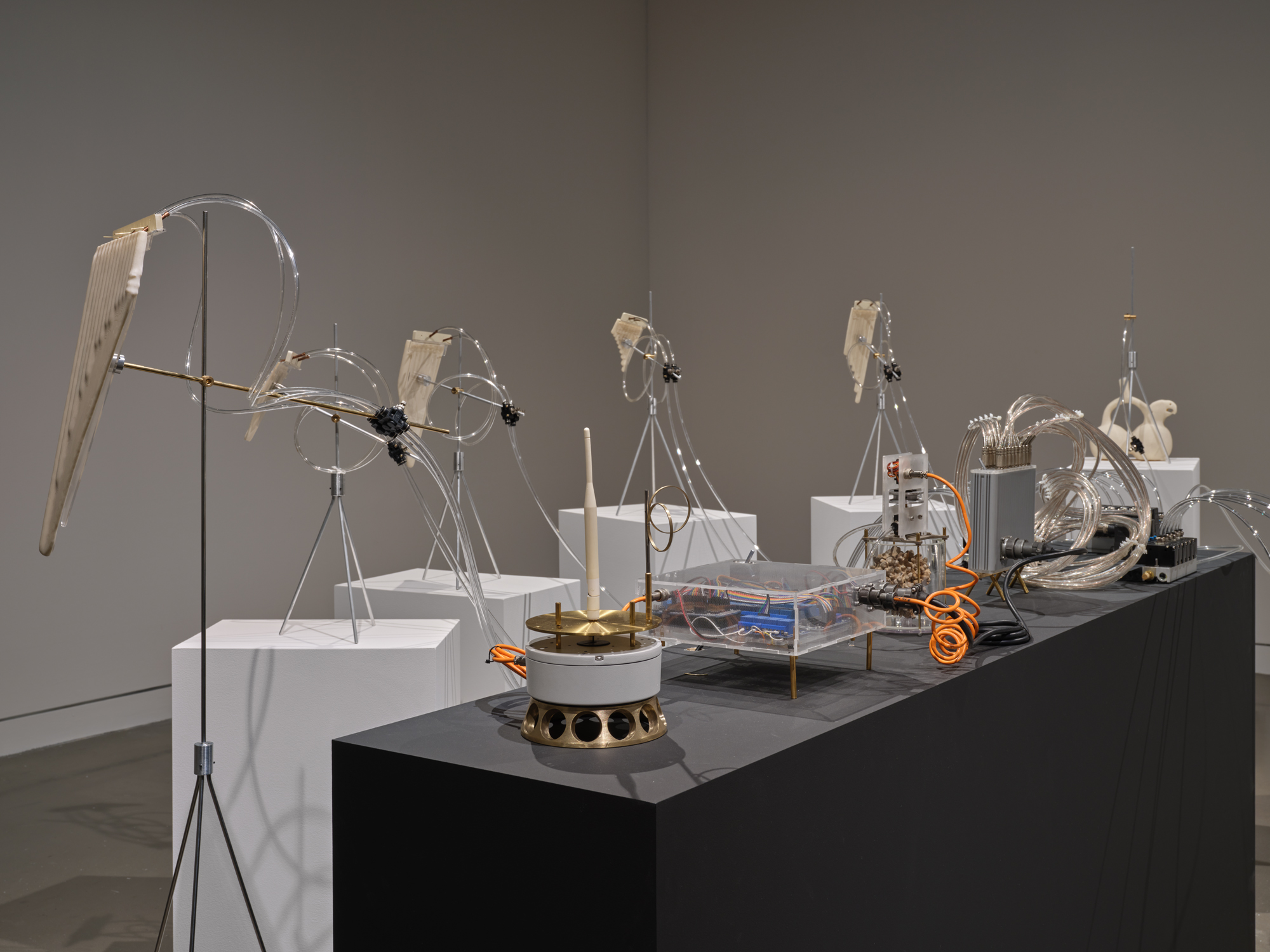
Biography
Cristhian Avila Cipriani is a multidisciplinary Artist living and working in Lima, Peru. He received a Bachelor of Arts from the Universidad Nacional Mayor de San Marcos. His artistic work is strongly linked to everyday life as a transformative element. The projects and processes that he develops show the ephemeral existence of acts that are directly linked to individual needs, such as, for example, the need to transcend, a need to leave traces or vestiges of having existed. His plans are balanced between going beyond memory of a simple act in particular of forgetting everything that is not important. He has exhibited in Lima, Arequipa, Trujillo, Cusco, Madrid, Italy and Rome. He received second place winner in the Photography category of Maravillarte 2022. IRRADIA 2020 award winner, organized by MALI (Lima Art Museum) and Fundación Telefónica del Perú. He has been part of the exhibits: En busca de algo perdido…Perú un sueño, MUNA 2021, Otra Feria, Lima + Santiago (2021), Dos Generaciones, Centro Cultural Británico drawing contest, Lima, 2021, Bellas Artes: Voz y huella de los egresados (1918-2018), Lima, 2018, Ojo Andino Perú, Venice, 2016, among others.
Credits
Prix Are Electronica 2022, Award of Distinction
2024 Version for New Media Gallery
Irradia Espacio Público Museo de Arte de Lima MALI
Fundación Telefónica del Perú Acknowledgements:
Carla Ávila
Ysabel Cipriani
Esteban Coronel
Bregy Malpartida
Hayashi Mateo
2021 Version
Credits: Jerson Ramirez, Yuriko Tanaka, Hayashi Mateo, Ronal Sanchez, Esteban Coronel, Fanel Contreras, Daniel Ocupa
With support from: Museum de Arte de Lima, MALI, Foundation Telefonica del Peru, Clinic Javiera Prado, Resocentro, 3D Rey, Municipalidad de Lima, Museum Central de Reserva, MUCEN, Colección Cohen, G&L ingenieros Corporacion, Red Animation Studio
Thanks to: Clinica Javier Prado, Resocentro
Ali Miharbi (Turkey)
Whispering 1, 2016 - 2022
10 3D printed acoustic resonators
Aluminum tube resonators, pneumatic valves, hoses, air compressor, microprocessor controlling air flow. The shapes of acoustic resonators are based on simplified vowel models producing the sounds A, E, O, U, and I. The sound sequences they produce are random.
Whispering (2016-2022) is a series of sound installations where acoustic resonators designed after human vocal tract models create whisper-like sounds by the air flowing through them. Whispering I (2016) utilizes compressed air flowing through 3D-printed acoustic resonators shaped after the forms that human vocal tract takes during speech. The sounds that the viewer hears while walking around the space resemble human whispering, as well as breathing. Sound sequences are controlled by a microprocessor and are based on the probabilities of the alphabet’s letters to succeed each other in a collection of texts, thus reflecting rhythms in language. The project was supported by BStart.
Whispering I (2016) utilizes compressed air flowing through 3D-printed acoustic resonators shaped after the forms that human vocal tract takes during speech. The sounds that the viewer hears while walking around the space resemble human whispering, as well as breathing. Sound sequences are controlled by a microprocessor and are based on the probabilities of the alphabet’s letters to succeed each other in a collection of texts, thus reflecting rhythms in language. The project was supported by BStart.
Image
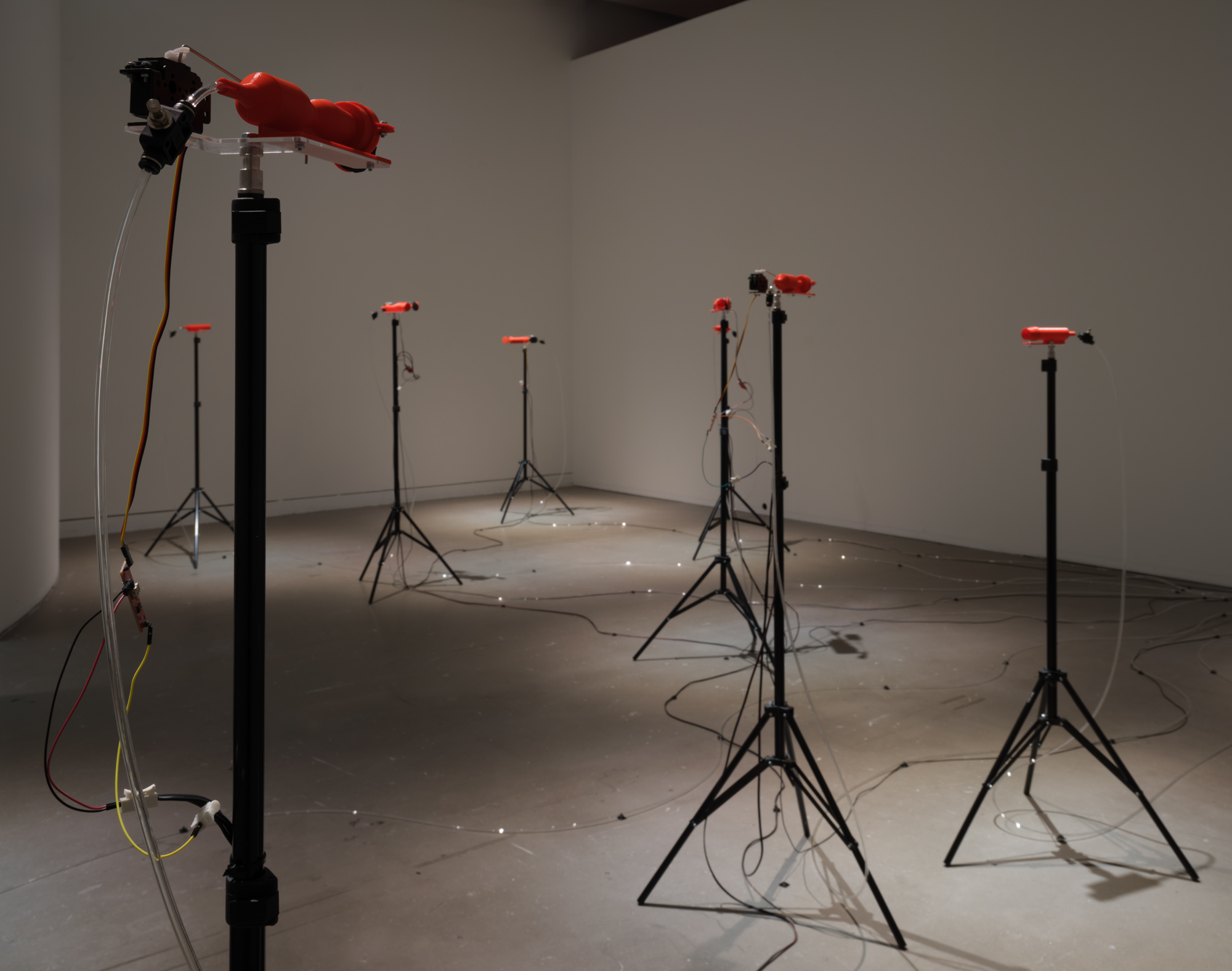
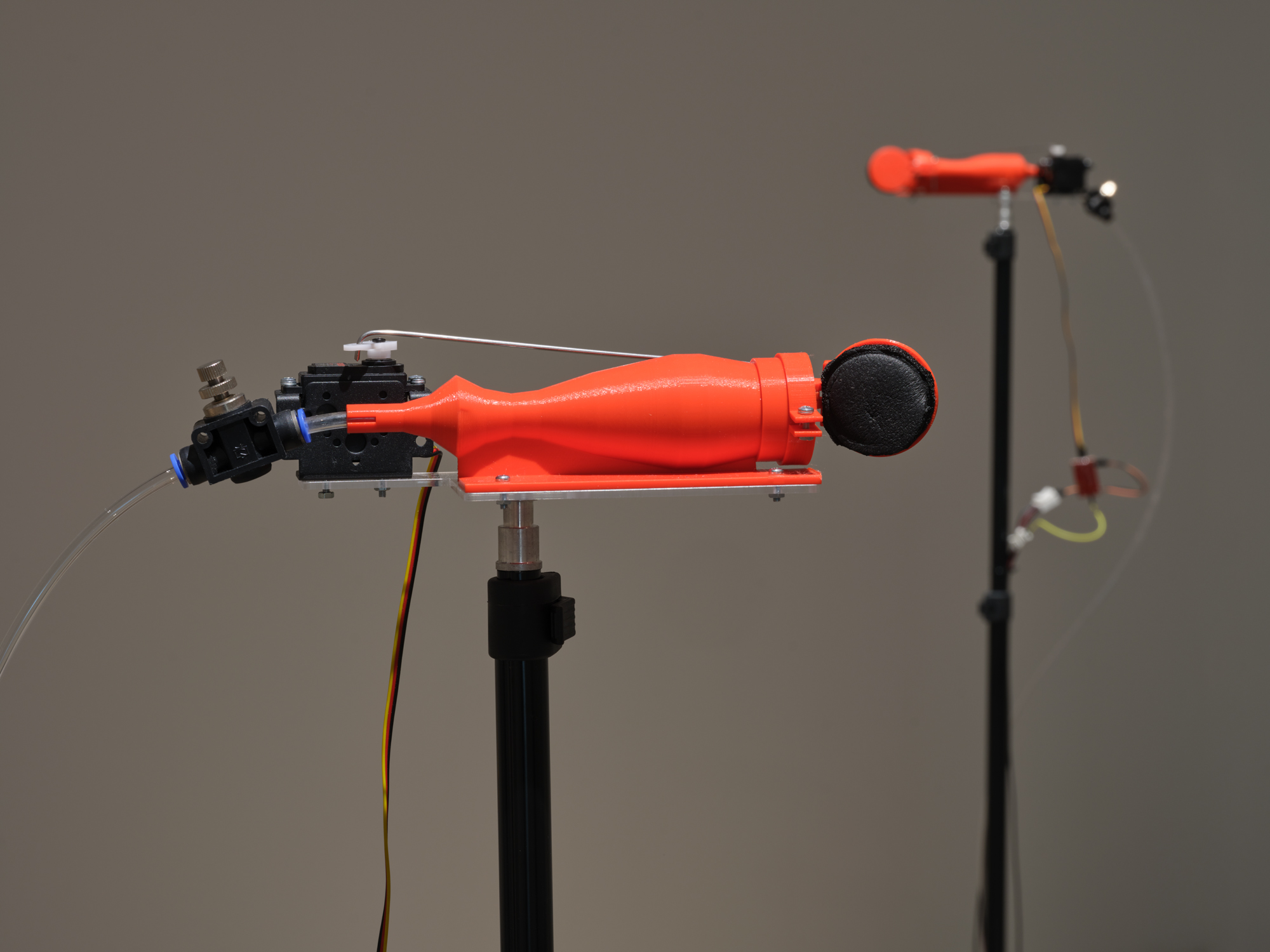
Biography
Ali Miharbi was born in 1976 in Istanbul where he currently lives and works. He obtained undergraduate degrees in Art Theory & Practice (BA, 2000) and Electrical & Computer Engineering (BS, 2000) from Northwestern University. He finished his MFA in Kinetic Imaging at Virginia Commonwealth University (2010). His work can take a variety of forms that range from photographic, graphic, sonic or sculptural pieces to dynamic systems driven by live or stored data. In addition to making relationships about culture and technology visible, his work also explores the modes of emotional and physical confinement in the contemporary world. Games with changed rules, machines that scratch, whip, tickle the walls of the exhibition space, or sighing, groaning, whispering air flows are some examples that viewers of his work can encounter. Navigating among social, technical and historical perspectives in a seriously playful manner, Miharbi explores the emergence and evolution of complex systems, our symbiotic relationship with artificial objects and the materiality behind information.
His solo exhibitions include "Degrees of Freedom", Pilot Gallery, Istanbul (2022), "Pneuma", Pilot Gallery, Istanbul (2017), "Stroke, Schauraum, MQ Vienna (2014), "On the Mechanical Operation of the Spirit", Pilot Gallery, Istanbul (2013) and "Séance", Interstate Projects, New York (2011). He was a resident artist at the Saha Studio Istanbul in 2022 and Delfina Foundation London in 2017.
Recent group exhibitions include: “Reveries, Truths” Casa Botter, Istanbul (2023), “Metamorphoses from Causal Relations to Indexical Signs”, Sanatorium, Istanbul (2022), “Tempo Incognito: On Flows, Rhythm, and Movement”, Depo, Istanbul (2021), “Intergalactic”, Anna Laudel, Istanbul (2019), “Machine Culture”, Pittsburgh International Festival, SPACE, Pittsburgh (2018), “Anger is a solution, if anger means kittens”, D21 Kunstraum Leipzig (2018), “Play is Freedom”, Bomontiada, Istanbul (2016), “Colomboscope 2016 – Testing Grounds: Art and Digital Cultures in South Asia and Europe”, Former General Post Office, Colombo (2016), “Home/s”, Benaki Museum, Athens (2013), “Turkish Art New and Superb”, TANAS, Berlin (2012).
Credits
BStart
Pilot Galeri, İstanbul, Türkiye
Xoán-Xil (Spain)
Organismo (Organscape) 2020
9 robotic bellows driven resonators
I The sound installation was commissioned by the festival De Lugares e Órganos (Santiago de Compostela 2020) and is framed around two coexisting elements ; the autonomous installation called Organismo I, a sort of automata that emulates a repertoire of sounds associated with the natural world, and a series of short pieces for organ composed by means of converting field recordings from different geographical locations to the characteristics of this historical instrument.
The project is based on research related to the special registers that are found in some organs, primarily of the Baroque period. Organscape imitates paramusical sounds, such as those of birds or thunder, and delves into representing the idea of our audible environment through a series of works. It is not so much an attempt to achieve a faithful imitation, but to outline certain acoustic characteristics of the evoked material, the wind, bird or a swarm, for example. Creating a tension that places us between utopia and dystopia.
In some way, the organ can be considered one of the first site-specific “installations”. It is a sound device built to remain in a fixed place, based on the acoustics of the space it occupies. This perspective, links the organ to the field of sound art and has inspired the framework of Organismo I. This modular device tries to emulate a natural sounds repertoire through the use of different acoustic mechanisms, such as bird calls, activated by the air from different bellows.
In this first phase, the work carried out focuses on a series of mechanical ornithology studies. The compositions entitled Variaciones para el Rei-Lúa have been inspired by the text, included in the work The Assassinated Poet, by the French writer Guillaume Apollinaire. Here the author recreates his imagined encounter with Luis II of Bavaria who, confined in a mysterious cave, played the keyboard of a fantastic organ to reproduce the sounds of different parts of the world; “The whistling of the geysers when the boiling augas erupt […], terrible noises from the street, trams, factories […], elephants sweep. One o´clock at night! This is India! Then Tibet. You can hear the priestly bells ringing […] Dum, Dum, boom, dum dum, boom, boom, dum, dum, boom, it’s Beijing, the gongs and the round drums, the innumerable dogs that shout or bark mixing their voices with the lugubrious sound of the night watchers. The crowing of a rooster bursts and announces the dawn ”. The organ as a sound representation of the world, as an audible equivalent of an imago mundi.
Image
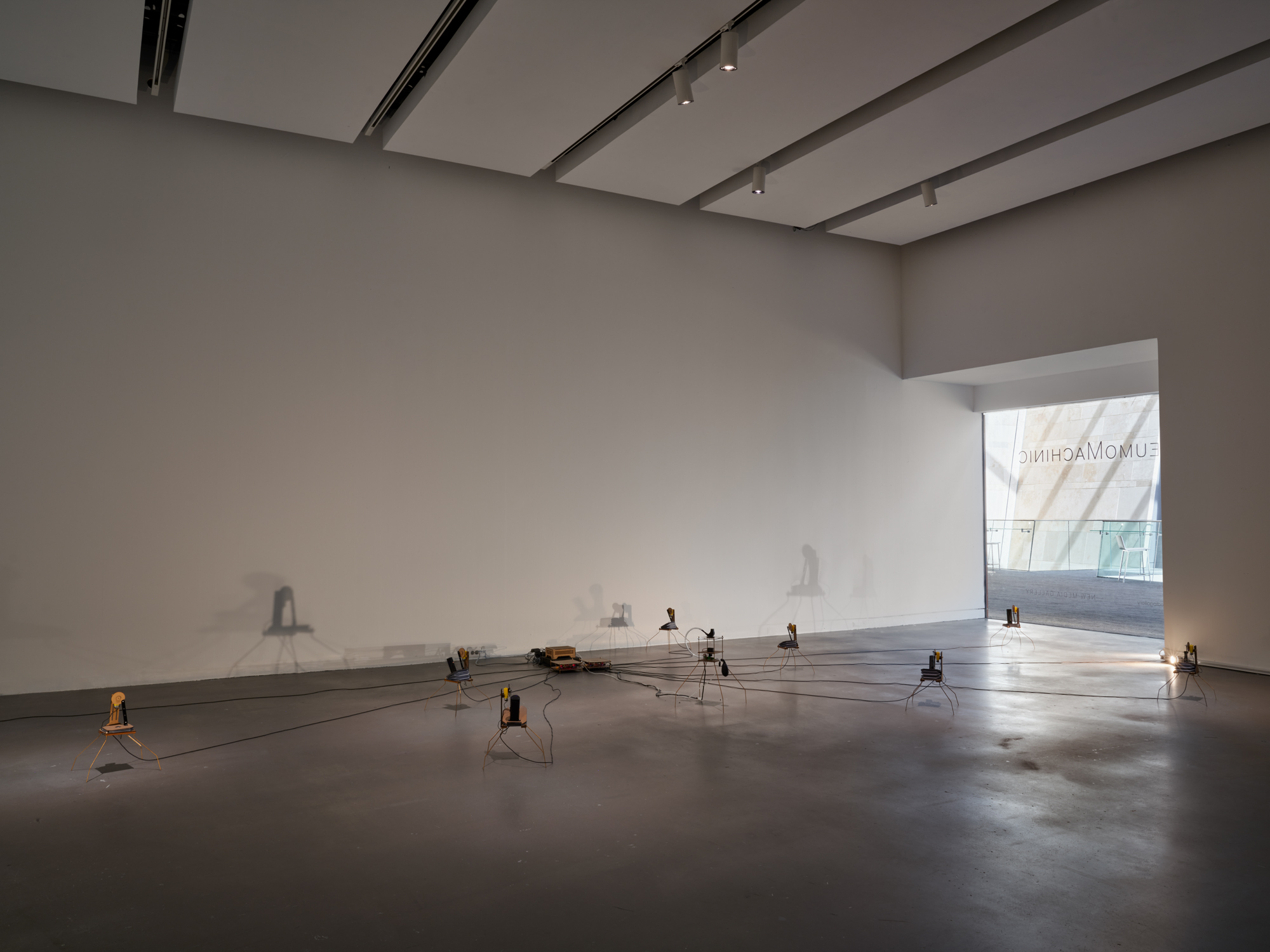
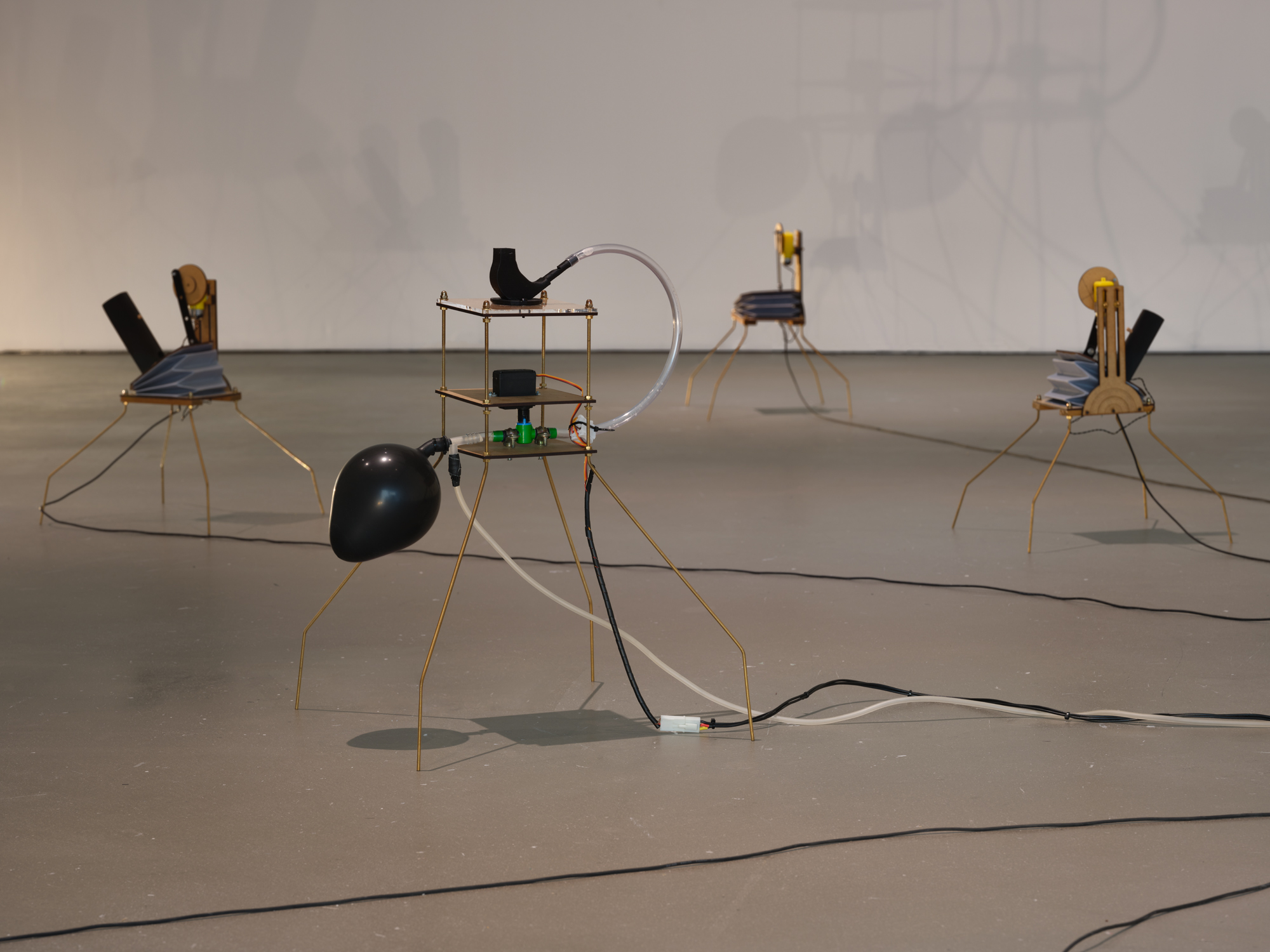
Biography
Xoán-Xil López is a sound artist and researcher whose work focuses on phonography (field recording) and sound experimentation taking the form of installations, immersive listening situations, compositions, performances and texts. He studied musicology and holds a PhD in Fine Arts with the Thesis Signal / Noise. He is part of the projects as Mediateletipos (sound Art), Ulobit (improvisation) and collaborates with different groups such as Vertixe Sonora or Arxis Ensemble contemporary music ensembles, Website Gigacircus company and Haarvöl electronic music proposal. He was one of the co-founders of Website Escoitar.org , an interdisciplinary collective dedicated to the study of the soundscape and aurality (cultural dimension of listening), which was active from 2006 to 2016. He teaches workshops, seminars and gives talks on Sound Art and field recording at universities around the world and curated conferences and workshops on sound. He has published on sound art MASE, for the International Encounter of Creation Sensxperiment and for the european research project on memory and listening European Acoustic Heritage (EAH) and O Abellón, a art/anthropology book focused on bees, drone sounds and ritual practices in Galicia (Spain). He has composed a series of works for pipe organ and a sound installation commissioned by De Lugares e Órganos festival and, recently work on sound design for Salvaxe, salvaxe and anti-documentary about wild wolfs on Galicia and north of Portugal. His work has been presented around the world.
Credits
Prix Are Electronica 2021
Honorary Mention De Lugares e Órganos (Santiago de Compostela, 2020)
Supercollider y OpenMusic
Adam Stag y Jerome Turmel
Donors, Partners, Thanks
Donors
Thompson-Wipp Family
Partners
Museo de Arte de Lima MALI, Peru
Thanks
Triane Tambay + Jamie Loh
